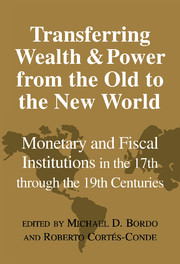 Transferring Wealth and Power from the Old to the New World
Transferring Wealth and Power from the Old to the New World Published online by Cambridge University Press: 27 March 2010
INTRODUCTION
In this chapter we study the structure of the fiscal system of the Viceroyalty of New Granada toward the end of the colonial period. Then we discuss how the tax system inherited from the Spanish Empire evolved over the period 1821–50.
The conclusion that emerges from the review of the evidence is that the new republic was successful in improving the tax regime it had received from Spain. By 1850, the Republic of New Granada possessed a fiscal system that was much more fair, efficient, and neutral than it had been in 1810.
In 1717 the Captaincy-General of New Granada was raised to the status of viceroyalty. However, six years later New Granada was again declared to be a Captaincy-General. Finally, in 1739 the Viceroyalty of New Granada was reestablished. The viceroyalty included basically the territory of what is now the Republic of Colombia plus Panamá; the Captaincy-General of Venezuela, over which it had very little control; and the Presidency of Quito. In this chapter, when we refer to the Viceroyalty of New Granada we only include the territory of the present republics of Colombia and Panamá.
In the 1810s, when most of the Spanish American colonies achieved their independence, the former territories of the Viceroyalty of New Granada formed the Republic of Colombia, comprising modern Venezuela, Colombia, Panamá, and Ecuador. However, by 1831 it had broken up into three separate republics: Venezuela, Ecuador, and New Granada.
To save this book to your Kindle, first ensure [email protected] is added to your Approved Personal Document E-mail List under your Personal Document Settings on the Manage Your Content and Devices page of your Amazon account. Then enter the ‘name’ part of your Kindle email address below. Find out more about saving to your Kindle.
Note you can select to save to either the @free.kindle.com or @kindle.com variations. ‘@free.kindle.com’ emails are free but can only be saved to your device when it is connected to wi-fi. ‘@kindle.com’ emails can be delivered even when you are not connected to wi-fi, but note that service fees apply.
Find out more about the Kindle Personal Document Service.
To save content items to your account, please confirm that you agree to abide by our usage policies. If this is the first time you use this feature, you will be asked to authorise Cambridge Core to connect with your account. Find out more about saving content to Dropbox.
To save content items to your account, please confirm that you agree to abide by our usage policies. If this is the first time you use this feature, you will be asked to authorise Cambridge Core to connect with your account. Find out more about saving content to Google Drive.